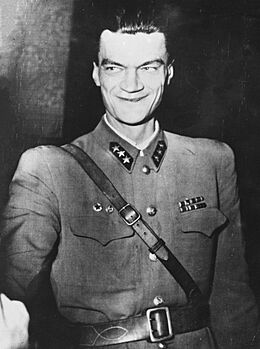Pál Maléter facts for kids
Quick facts for kids
Pál Maléter
|
|
|---|---|

Maléter in 1956
|
|
| Born | 4 September 1917 Eperjes, Sáros County, Kingdom of Hungary, Austria-Hungary |
| Died | 16 June 1958 (aged 40) Budapest, Hungarian People's Republic |
| Cause of death | Execution by hanging |
| Allegiance | |
| Years of service | 1942–1956 |
| Rank | Colonel General |
| Battles/wars | World War II
Hungarian Revolution of 1956 |
Pál Maléter (born September 4, 1917 – died June 16, 1958) was an important military leader during the Hungarian Revolution of 1956. This was a big uprising where people in Hungary tried to gain more freedom from Soviet influence. Maléter became a hero for many because he sided with the people fighting for change.
Contents
Pál Maléter: A Hero of the Hungarian Revolution
Early Life and Military Beginnings
Pál Maléter was born in 1917 in a city called Eperjes. This city was part of Hungary back then. Today, it is known as Prešov in Slovakia. He first studied medicine at Charles University in Prague. Later, in 1938, he moved to Budapest. There, he decided to join the military academy.
During World War II, Maléter fought on the Eastern Front. He was part of the Axis forces. He was later captured by the Soviet Red Army. After this, he became a communist. He was trained in special operations, like sabotage, which means secretly damaging things. He fought against the Germans in Transylvania. He was known for his bravery and daring actions. In 1945, he joined the Hungarian Communist Party.
Role in the 1956 Hungarian Revolution
By 1956, Maléter was a Colonel. He worked with the General Staff in Budapest. The General Staff is like the main planning group for the army. During the Hungarian Revolution of 1956, he was sent to help a unit at the Kilian barracks. He went with tanks and a group of officer cadets.
However, only Maléter's tank reached the barracks. With permission from his leaders, he agreed to a cease-fire. This was with the groups of people who were rebelling. Soon after, Maléter made a big decision. He switched sides and joined the rebels. He helped them defend the Kilian Barracks against Soviet troops. He was the most important military officer to join the uprising. He chose to support the people, not the communist government.
Becoming Minister of Defense
Because he was a key military figure among the rebels, he met with the new government. On October 29, he was made the Minister of Defense. This is a very important job, overseeing the country's military. On November 2, he was promoted to Major General.
On November 3, Maléter went to Tököl, near Budapest. He was there to talk with the Soviet military forces. But during these talks the next day, something unfair happened. Soviet officers arrested Maléter. This was against international law, which are rules for how countries should act. He was then put in prison.
A Tragic End and Honored Memory
Pál Maléter was executed on June 16, 1958. This happened in a Budapest prison. He was executed along with Imre Nagy, who was the Prime Minister, and others. They were accused of trying to overthrow the government.
In June 1989, many years later, Maléter and Nagy were honored. They were formally reburied in Budapest with full honors. This was a way to remember their sacrifice. Maléter was also promoted to Colonel General after his death. This showed how important he was.
Maléter was known for being very tall. He was over two meters (more than six feet eight inches) tall! There is even a type of pine tree named after him, a dwarf variety.

